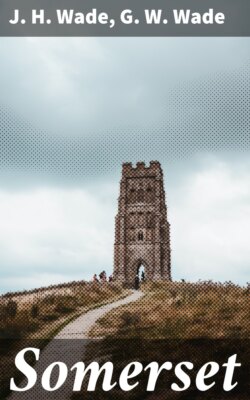Somerset

Реклама. ООО «ЛитРес», ИНН: 7719571260.
Оглавление
G. W. Wade. Somerset
Somerset
Table of Contents
PREFACE
SOMERSET. LIST OF ILLUSTRATIONS
INTRODUCTION
SITUATION AND EXTENT
CLIMATE
COMMUNICATIONS
PHYSICAL FEATURES AND GEOLOGY
FAUNA AND FLORA
HISTORY
ANTIQUITIES
INDUSTRIES
CELEBRITIES
DESCRIPTION OF PLACES IN SOMERSET ARRANGED ALPHABETICALLY
APPENDIX
INDEX OF PERSONS
Отрывок из книги
G. W. Wade, J. H. Wade
Published by Good Press, 2019
.....
2. The most interesting Roman remains are at Bath, where a splendid system of baths has been brought to light. Villas and other buildings of Roman origin have been discovered at Whitestaunton and Wadeford (near Chard), Whatley (near Frome), Wellow, Newton St. Loe, Bratton Seymour, Pitney, Camerton, etc. Traces of Roman mines (such as tools and pigs of lead) have been found at Priddy and Blagdon, and an amphitheatre at Charterhouse-on-Mendip. Many of the British camps enumerated above have at different times been occupied by the Roman legions.
3. The ancient ecclesiastical buildings of Somerset are very interesting. Some of them, chiefly monastic foundations, are more or less in ruins—Glastonbury, Cleeve, Woodspring, Muchelney, Stavordale, Hinton Charterhouse. Of those that are still used for religious purposes, the most conspicuous are Wells Cathedral and Bath Abbey. But the parish churches, in their way, are almost as remarkable. Their excellence is largely due to the splendid building-stone which abounds in different parts of the county, especially near Bath, Dundry, Doulting, and Ham Hill. Of Saxon architecture Somerset has no example such as Wilts possesses in Bradford, though some of the ancient fonts may possibly be of pre-Norman origin. The majority of early fonts, however, are Norman, and the number of them shows how thickly Norman churches once covered the country. But surviving instances of churches wholly or mainly Norman are rare: the best examples are Compton Martin, Christon, and Stoke-sub-Hamdon. There is herring-bone work at Elm and Marston Magna. Of Norman chancel arches and doorways retained when the body of the church has been re-constructed the examples are numerous; noteworthy are those at Glastonbury, Milborne Port, Stoke-Courcy, Lullington, Huish Episcopi, Portbury, St. Catherine, South Stoke, Flax Bourton, Langridge, Clevedon, Chewton Mendip, Englishcombe. Wells Cathedral contains some splendid Transitional work, of which there are also specimens at Clutton. Complete churches of the Early English and Decorated periods are few, but many buildings preserve specimens of these styles in combination with work of a later date. The W. front of Wells is a beautiful example of E.E., and windows of this period occur at E. Stoke, Bathampton, Chedzoy, Martock, Keynsham, Somerton. There are E.E. arcades at St. Cuthbert's, Wells, and further illustrations of E.E. work are furnished by Compton Bishop, Creech St. Michael, Stoke St. Gregory, etc. Decorated windows are found at Ditcheat, Compton Dundon, Huish Champflower, Shipton Beauchamp, Barrington, Montacute, Brympton, and very fine ones in the choir and lady chapel at Wells. In many parish churches the chancels have been retained when the rest of the building was reconstructed, with the result that, whilst they often preserve early work, and are accordingly of the greatest interest, they appear relatively to their surroundings insignificant and mean.
.....